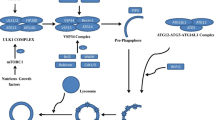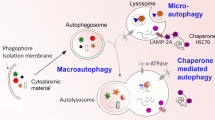Abstract
Lysosomes degrade dysfunctional intracellular components via three pathways: macroautophagy, microautophagy, and chaperone-mediated autophagy (CMA). Unlike the other two, CMA degrades cytosolic proteins with a recognized KFERQ-like motif in lysosomes and is important for cellular homeostasis. CMA activity declines with age and is altered in neurodegenerative diseases. Its impairment leads to the accumulation of aggregated proteins, some of which may be directly tied to the pathogenic processes of neurodegenerative diseases. Its induction may accelerate the clearance of pathogenic proteins and promote cell survival, representing a potential therapeutic approach for the treatment of neurodegenerative diseases. In this review, we summarize the current findings on how CMA is involved in neurodegenerative diseases, especially in Parkinson’s disease.
Similar content being viewed by others
References
Klionsky DJ, Emr SD. Autophagy as a regulated pathway of cellular degradation. Science 2000, 290: 1717–1721.
Levine B, Klionsky DJ. Development by self-digestion: molecular mechanisms and biological functions of autophagy. Dev Cell 2004, 6: 463–477.
Mizushima N, Ohsumi Y, Yoshimori T. Autophagosome formation in mammalian cells. Cell Struct Funct 2002, 27: 421–429.
Ahlberg J, Glaumann H. Uptake—microautophagy—and degradation of exogenous proteins by isolated rat liver lysosomes: effects of pH, ATP, and inhibitors of proteolysis. Exp Mol Pathol 1985, 42: 78–88.
Mortimore G, Lardeux B, Adams C. Regulation of microautophagy and basal protein turnover in rat liver. Effects of short-term starvation. J Biol Chem 1988, 263: 2506–2512.
Müller O, Sattler T, Flötenmeyer M, Schwarz H, Plattner H, Mayer A. Autophagic tubes vacuolar invaginations involved in lateral membrane sorting and inverse vesicle budding. J Cell Biol 2000, 151: 519–528.
Dice JF. Lysosomal pathways of protein degradation. Landes Bioscience Austin, TX, 2000.
Cuervo AM, Stefanis L, Fredenburg R, Lansbury PT, Sulzer D. Impaired degradation of mutant a-synuclein by chaperonemediated autophagy. Science 2004, 305: 1292–1295.
Kon M, Cuervo AM. Chaperone-mediated autophagy in health and disease. FEBS Lett 2010, 584: 1399–1404.
Thompson LM, Aiken CT, Kaltenbach LS, Agrawal N, Illes K, Khoshnan A, et al. IKK phosphorylates Huntingtin and targets it for degradation by the proteasome and lysosome. J Cell Biol 2009, 187: 1083–1099.
Alvarez-Erviti L, Rodriguez-Oroz MC, Cooper JM, Caballero C, Ferrer I, Obeso JA, et al. Chaperone-mediated autophagy markers in Parkinson disease brains. Arch Neurol 2010, 67: 1464–1472.
Koga H, Martinez-Vicente M, Arias E, Kaushik S, Sulzer D, Cuervo AM. Constitutive upregulation of chaperone-mediated autophagy in Huntington's disease. J Neurosci 2011, 31: 18492–18505.
Li W, Yang Q, Mao Z. Chaperone-mediated autophagy: machinery, regulation and biological consequences. Cell Mol Life Sci 2011, 68: 749–763.
Dice JF. Peptide sequences that target cytosolic proteins for lysosomal proteolysis. Trends Biochem Sci 1990, 15: 305–309.
Cuervo AM, Wong E. Chaperone-mediated autophagy: roles in disease and aging. Cell Res 2014, 24: 92–104.
Kaushik S, Cuervo AM. Chaperone–mediated autophagy: a unique way to enter the lysosome world. Trends Cell Biol 2012, 22: 407–417.
Cuervo AM, Terlecky SR, Dice JF, Knecht E. Selective binding and uptake of ribonuclease A and glyceraldehyde-3- phosphate dehydrogenase by isolated rat liver lysosomes. J Biol Chem 1994, 269: 26374–26380.
Majeski AE, Dice JF. Mechanisms of chaperone-mediated autophagy. Int J Biochem Cell Biol 2004, 36: 2435–2444.
Orenstein SJ, Cuervo AM. Chaperone-mediated autophagy: molecular mechanisms and physiological relevance. Semin Cell Dev Biol 2010, 21: 719–726.
Agarraberes FA, Dice JF. A molecular chaperone complex at the lysosomal membrane is required for protein translocation. J Cell Sci 2001, 114: 2491–2499.
Salvador N, Aguado C, Horst M, Knecht E. Import of a cytosolic protein into lysosomes by chaperone-mediated autophagy depends on its folding state. J Biol Chem 2000, 275: 27447–27456.
Agarraberes FA, Terlecky SR, Dice JF. An intralysosomal hsp70 is required for a selective pathway of lysosomal protein degradation. J Cell Biol 1997, 137: 825–834.
Cuervo AM, Dice JF. A receptor for the selective uptake and degradation of proteins by lysosomes. Science 1996, 273: 501–503.
Cuervo A, Dice J. Unique properties of lamp2a compared to other lamp2 isoforms. J Cell Sci 2000, 113: 4441–4450.
Bandyopadhyay U, Kaushik S, Varticovski L, Cuervo AM. The chaperone-mediated autophagy receptor organizes in dynamic protein complexes at the lysosomal membrane. Mol Cell Biol 2008, 28: 5747–5763.
Dice J, Chiang H, Spencer E, Backer J. Regulation of catabolism of microinjected ribonuclease A. Identifi cation of residues 7-11 as the essential pentapeptide. J Biol Chem 1986, 261: 6853–6859.
Finn PF, Mesires NT, Vine M, Dice JF. Effects of small molecules on chaperone-mediated autophagy. Autophagy 2005, 1: 141–145.
Wing S, Chiang H, Goldberg A, Dice J. Proteins containing peptide sequences related to Lys-Phe-Glu-Arg-Gln are selectively depleted in liver and heart, but not skeletal muscle, of fasted rats. Biochem J 1991, 275: 165–169.
Susan P, Dunn W. Starvation-induced lysosomal degradation of aldolase B requires glutamine 111 in a signal sequence for chaperone-mediated transport. J Cell Physiol 2001, 187: 48–58.
Pemberton S, Madiona K, Pieri L, Kabani M, Bousset L, Melki R. Hsc70 protein interaction with soluble and fibrillar a-synuclein. J Biol Chem 2011, 286: 34690–34699.
Arndt V, Dick N, Tawo R, Dreiseidler M, Wenzel D, Hesse M, et al. Chaperone-assisted selective autophagy is essential for muscle maintenance. Curr Biol 2010, 20: 143–148.
Cuervo AM, Dice JF, Knecht E. A population of rat liver lysosomes responsible for the selective uptake and degradation of cytosolic proteins. J Biol Chem 1997, 272: 5606–5615.
Gao L, She H, Li W, Zeng J, Zhu J, Jones DP, et al. Oxidation of survival factor MEF2D in neuronal death and Parkinson's disease. Antioxid Redox Signal 2014, 20: 2936–2948.
Bandyopadhyay U, Sridhar S, Kaushik S, Kiffin R, Cuervo AM. Identification of regulators of chaperone-mediated autophagy. Mol Cell 2010, 39: 535–547.
Nedelsky NB, Todd PK, Taylor JP. Autophagy and the ubiquitin-proteasome system: collaborators in neuroprotection. Biochim Biophys Acta 2008, 1782: 691–699.
Massey AC, Follenzi A, Kiffi n R, Zhang C, Cuervo AM. Early cellular changes after blockage of chaperone-mediated autophagy. Autophagy 2008, 4: 442–456.
Modgil S, Lahiri DK, Sharma VL, Anand A. Role of early life exposure and environment on neurodegeneration: implications on brain disorders. Transl Neurodegener 2014, 3.
McInnes J. Insights on altered mitochondrial function and dynamics in the pathogenesis of neurodegeneration. Transl Neurodegener 2013, 2: 12.
Rodriguez-Navarro JA, Cuervo AM. Dietary lipids and aging compromise chaperone-mediated autophagy by similar mechanisms. Autophagy 2012, 8: 1152–1154.
Cuervo AM, Dice JF. Age-related decline in chaperonemediated autophagy. J Biol Chem 2000, 275: 31505–31513.
Kiffin R, Kaushik S, Zeng M, Bandyopadhyay U, Zhang C, Massey AC, et al. Altered dynamics of the lysosomal receptor for chaperone-mediated autophagy with age. J Cell Sci 2007, 120: 782–791.
Marin C, Aguilar E. In vivo 6-OHDA-induced neurodegeneration and nigral autophagic markers expression. Neurochem Int 2011, 58: 521–526.
Sala G, Arosio A, Stefanoni G, Melchionda L, Riva C, Marinig D, et al. Rotenone upregulates alpha-synuclein and myocyte enhancer factor 2D independently from lysosomal degradation inhibition. BioMed Res Int 2013, 2013.
Dohi E, Tanaka S, Seki T, Miyagi T, Hide I, Takahashi T, et al. Hypoxic stress activates chaperone-mediated autophagy and modulates neuronal cell survival. Neurochem Int 2012, 60: 431–442.
Zhang C, Cuervo AM. Restoration of chaperone-mediated autophagy in aging liver improves cellular maintenance and hepatic function. Nature medicine 2008, 14: 959–965.
Kiffin R, Christian C, Knecht E, Cuervo AM. Activation of chaperone-mediated autophagy during oxidative stress. Mol Biol Cell 2004, 15: 4829–4840.
Cuervo AM, Hu W, Lim B, Dice JF. IkB is a substrate for a selective pathway of lysosomal proteolysis. Mol Biol Cell 1998, 9: 1995–2010.
Lesage S, Brice A. Parkinson's disease: from monogenic forms to genetic susceptibility factors. Hum Mol Genet 2009, 18: R48–R59.
Polymeropoulos MH, Lavedan C, Leroy E, Ide SE, Dehejia A, Dutra A, et al. Mutation in the alpha-synuclein gene identifi ed in families with Parkinson's disease. Science 1997, 276: 2045–2047.
Vogiatzi T, Xilouri M, Vekrellis K, Stefanis L. Wild type a-synuclein is degraded by chaperone-mediated autophagy and macroautophagy in neuronal cells. J Biol Chem 2008, 283: 23542–23556.
Martinez-Vicente M, Talloczy Z, Kaushik S, Massey AC, Mazzulli J, Mosharov EV, et al. Dopamine-modified a-synuclein blocks chaperone-mediated autophagy. J Clin Invest 2008, 118: 777.
Qi L, Zhang X-D, Wu J-C, Lin F, Wang J, Di Figlia M, et al. The role of chaperone-mediated autophagy in huntingtin degradation. PLoS One 2012, 7: e46834.
Mak SK, Mc Cormack AL, Manning-Bog AB, Cuervo AM, Di Monte DA. Lysosomal degradation of alpha-synuclein in vivo. J Biol Chem 2010, 285: 13621–13629.
Lynch-Day MA, Mao K, Wang K, Zhao M, Klionsky DJ. The role of autophagy in Parkinson’s disease. Cold Spring Harb Perspect Med 2012, 2: a009357.
Alegre-Abarrategui J, Christian H, Lufino MM, Mutihac R, Venda LL, Ansorge O, et al. LRRK2 regulates autophagic activity and localizes to specifi c membrane microdomains in a novel human genomic reporter cellular model. Hum Mol Genet 2009, 18: 4022–4034.
Orenstein SJ, Kuo S-H, Tasset I, Arias E, Koga H, Fernandez- Carasa I, et al. Interplay of LRRK2 with chaperone-mediated autophagy. Nat Neurosci 2013, 16: 394–406.
Choi J, Levey AI, Weintraub ST, Rees HD, Gearing M, Chin L-S, et al. Oxidative modifications and down-regulation of ubiquitin carboxyl-terminal hydrolase L1 associated with idiopathic Parkinson's and Alzheimer's diseases. J Biol Chem 2004, 279: 13256–13264.
Kabuta T, Furuta A, Aoki S, Furuta K, Wada K. Aberrant interaction between Parkinson disease-associated mutant UCH-L1 and the lysosomal receptor for chaperone-mediated autophagy. J Biol Chem 2008, 283: 23731–23738.
Gong X, Tang X, Wiedmann M, Wang X, Peng J, Zheng D, et al. Cdk5-mediated inhibition of the protective effects of transcription factor MEF2 in neurotoxicity-induced apoptosis. Neuron 2003, 38: 33–46.
Wang X, Tang X, Li M, Marshall J, Mao Z. Regulation of neuroprotective activity of myocyte-enhancer factor 2 by cAMP-protein kinase A signaling pathway in neuronal survival. J Biol Chem 2005, 280: 16705–16713.
Tang X, Wang X, Gong X, Tong M, Park D, Xia Z, et al. Cyclin-dependent kinase 5 mediates neurotoxin-induced degradation of the transcription factor myocyte enhancer factor 2. J Neurosci 2005, 25: 4823–4834.
Yang Q, She H, Gearing M, Colla E, Lee M, Shacka JJ, et al. Regulation of neuronal survival factor MEF2D by chaperonemediated autophagy. Science 2009, 323: 124–127.
Irrcher I, Park DS. Parkinson’s disease: to live or die by autophagy. Sci Signaling 2009, 2: pe21–pe21.
Murphy KE, Gysbers AM, Abbott SK, Spiro AS, Furuta A, Cooper A, et al. Lysosomal-associated membrane protein 2 Isoforms Are Differentially Affected in Early Parkinson's Disease. Mov Disord 2015.
Wang Y, Martinez-Vicente M, Krüger U, Kaushik S, Wong E, Mandelkow E-M, et al. Tau fragmentation, aggregation and clearance: the dual role of lysosomal processing. Hum Mol Genet 2009, 18: 4153–4170.
Khoshnan A, Ko J, Tescu S, Brundin P, Patterson PH. IKKa and IKKß regulation of DNA damage-induced cleavage of huntingtin. PLoS One 2009, 4: e5768.
Huang CC, Bose JK, Majumder P, Lee KH, Huang JTJ, Huang JK, et al. Metabolism and mis-metabolism of the neuropathological signature protein TDP-43. J Cell Sci 2014, 127: 3024–3038.
Fleming A, Noda T, Yoshimori T, Rubinsztein DC. Chemical modulators of autophagy as biological probes and potential therapeutics. Nature Chem Biol 2011, 7: 9–17.
Rubinsztein DC, Codogno P, Levine B. Autophagy modulation as a potential therapeutic target for diverse diseases. Nat Rev Drug Discov 2012, 11: 709–730.
Xilouri M, Vogiatzi T, Vekrellis K, Park D, Stefanis L. Abberant a-synuclein confers toxicity to neurons in part through inhibition of chaperone-mediated autophagy. PLoS One 2009, 4: e5515.
Xilouri M, Brekk OR, Landeck N, Pitychoutis PM, Papasilekas T, Papadopoulou- Daifoti Z, et al. Boosting chaperonemediated autophagy in vivo mitigates a-synuclein-induced neurodegeneration. Brain 2013, 136: 2130–2146.
Xilouri M, Brekk OR, Stefanis L. Alpha-synuclein and protein degradation systems: a reciprocal relationship. Mol Neurobiol 2013, 47: 537–551.
Author information
Authors and Affiliations
Corresponding author
Rights and permissions
About this article
Cite this article
Liu, X., Huang, S., Wang, X. et al. Chaperone-mediated autophagy and neurodegeneration: connections, mechanisms, and therapeutic implications. Neurosci. Bull. 31, 407–415 (2015). https://doi.org/10.1007/s12264-015-1542-8
Received:
Accepted:
Published:
Issue Date:
DOI: https://doi.org/10.1007/s12264-015-1542-8




